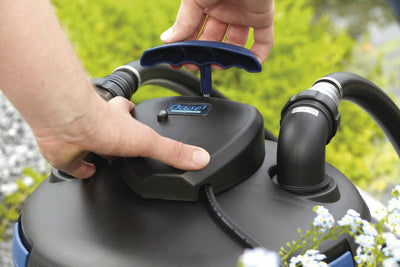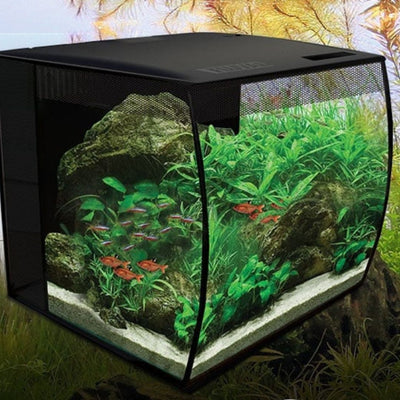 Whether you have a backyard pond, a koi pond, or a larger water feature, proper maintenance is essential to keep your pond looking beautiful and your fish happy.
Whether you have a backyard pond, a koi pond, or a larger water feature, proper maintenance is essential to keep your pond looking beautiful and your fish happy.
In this guide, we will cover everything you need to know about pond cleaning, including removing debris, managing algae and bacteria, and maintaining the water quality. We'll also provide expert tips and tricks to streamline your cleaning routine and make it easier for you to enjoy your pond.
Here at We Know Pets, we have trained aquaculturists on the team who understand the importance of maintaining a clean and healthy pond & can provide advise. With our years of experience and expertise, we have developed foolproof techniques to help you keep your pond in top shape. So, whether you're a beginner or a seasoned pond owner, this guide will provide you with the knowledge and tools you need to achieve a crystal-clear and thriving pond ecosystem.
Why is pond cleaning important?
Maintaining a clean and healthy pond is essential for the well-being of your pond ecosystem. Regular pond cleaning helps to prevent the buildup of debris, organic matter, and harmful bacteria, which can lead to a variety of issues. A dirty pond can become a breeding ground for algae, which can not only make the water appear murky and unappealing but can also deplete the oxygen levels, putting the health of your fish and other aquatic life at risk.
Proper pond cleaning also helps to maintain the water quality, ensuring that the pH levels, temperature, and nutrient balance are optimal for your pond's inhabitants. Without regular cleaning, these factors can become imbalanced, leading to stress and illness in your fish and other aquatic creatures. Additionally, a well-maintained pond is less likely to develop foul odours or become a haven for mosquitoes and other pests, making it a more enjoyable and safe feature in your outdoor space.
By taking the time to clean your pond on a regular basis, you can create a thriving and visually appealing water feature that will bring joy and relaxation to your backyard.
Signs that your pond needs cleaning
Identifying that your pond needs cleaning is the first step in maintaining a healthy and visually appealing water feature. One of the most obvious indicators is the presence of excess algae growth, which can manifest as a green, slimy coating on the water's surface or along the pond's walls and bottom.
Another telltale sign is the buildup of debris, such as leaves, twigs, and other organic matter, which can accumulate over time and contribute to the deterioration of water quality. This debris can provide a breeding ground for bacteria and create an imbalance in the pond's ecosystem, leading to issues like poor oxygen levels and the growth of harmful microorganisms.
Changes in the water's clarity and colour can also be a sign that your pond needs attention. If the water appears murky, discoloured, or has a bad odour, it's likely that the water quality has been compromised and needs to be addressed through a thorough cleaning and maintenance routine.
Additionally, if you notice a decline in the health or behaviour of your pond's inhabitants, such as fish or aquatic plants, it may be an indication that the water quality has deteriorated and requires immediate attention. By staying vigilant and recognising these signs, you can proactively address any issues and maintain a thriving and balanced pond ecosystem.
Tools and materials needed for pond cleaning
 Proper pond cleaning requires a specific set of tools and materials to ensure the job is done efficiently and effectively. The first and most essential item is a pond vacuum, which is designed to suck up debris, organic matter, and accumulated sludge from the pond's bottom and walls.
Proper pond cleaning requires a specific set of tools and materials to ensure the job is done efficiently and effectively. The first and most essential item is a pond vacuum, which is designed to suck up debris, organic matter, and accumulated sludge from the pond's bottom and walls.
In addition to the pond vacuum, you'll need a pond net or skimmer to remove floating debris, such as leaves and twigs, from the water's surface. A long-handled pond brush can also be useful for scrubbing the pond's walls and removing stubborn algae growth.
Depending on the size and complexity of your pond, you may also need a pond pump and filter system to help maintain water circulation and filtration. These components are crucial for keeping the water clean and oxygenated, as well as for removing any dissolved organic matter or excess nutrients that can contribute to algae growth.
Other essential items for pond cleaning include water testing kits, water conditioners, and beneficial bacteria supplements. These tools and products will help you monitor and maintain the water quality, as well as introduce beneficial microorganisms that can naturally break down organic matter and prevent the buildup of harmful compounds.
help you monitor and maintain the water quality, as well as introduce beneficial microorganisms that can naturally break down organic matter and prevent the buildup of harmful compounds.
By having the right tools and materials on hand, you can streamline the pond cleaning process and ensure that your water feature remains in top condition throughout the year. Remember to always follow the manufacturer's instructions and safety guidelines when using any pond-related equipment or chemicals.
Step-by-step guide to cleaning your pond
Cleaning a pond can seem like a daunting task, but with the right approach and a little elbow grease, you can achieve a pristine and healthy water feature. Here's a step-by-step guide to help you get started:
- Prepare the pond: Before you begin the cleaning process, it's important to ensure that the pond is safe for you and your aquatic inhabitants. Turn off any electrical equipment, such as pumps or filters.
- Remove debris and organic matter: Use a pond net or skimmer to remove any floating debris, such as leaves, twigs, or algae, from the water's surface. Then, use a pond vacuum to thoroughly clean the bottom and walls of the pond, sucking up any accumulated sludge or organic matter. It is best not to remove more then 50% of the water at a time as this can stress the fish. If you pond is extremely dirty then you may need to use the Vac several times.
- Clean the pond filter: If your pond has a filter system, it's essential to clean it thoroughly to ensure it's functioning correctly. Follow the manufacturer's instructions to disassemble the filter, clean the media, and remove any buildup of debris or algae.
- Treat for algae: Once the physical cleaning is complete, it's time to address any algae issues. Use an algaecide or other pond-safe chemicals to help control and prevent the growth of algae. Be sure to follow the product instructions carefully and test the water quality to ensure the treatment is effective and safe for your pond's inhabitants.
- Introduce beneficial bacteria: After treating for algae, it's important to replenish the pond's beneficial bacteria population. These microorganisms play a crucial role in breaking down organic matter and maintaining a healthy water balance. Use a pond-safe bacteria supplement to inoculate the water and help establish a thriving ecosystem.
- Test and adjust water parameters: Use a water testing kit to check the pH, ammonia, nitrite, and nitrate levels in your pond. If any of these parameters are out of the ideal range, make the necessary adjustments by adding appropriate water conditioners or performing a partial water change. A pH for a pond between 7.0 and 7.4 is ideal.
- Maintain and monitor: Regularly maintain your pond by removing debris, cleaning the filter, and monitoring the water quality. Depending on the size and complexity of your pond, you may need to perform a more thorough cleaning every few months or annually to keep it in top condition.
By following this step-by-step guide, you can ensure that your pond remains clean, healthy, and visually appealing throughout the year. Remember to be patient and consistent in your pond maintenance efforts, as a well-maintained water feature will bring you years of enjoyment and relaxation.
Removing debris and organic matter from the pond
One of the most important aspects of pond cleaning is the removal of debris and organic matter that can accumulate over time. This debris can come from a variety of sources, such as leaves, twigs, and other plant material, as well as fish waste and uneaten food. If left unchecked, this organic matter can lead to a buildup of sludge on the pond's bottom, which can create an ideal breeding ground for harmful bacteria and algae.
organic matter that can accumulate over time. This debris can come from a variety of sources, such as leaves, twigs, and other plant material, as well as fish waste and uneaten food. If left unchecked, this organic matter can lead to a buildup of sludge on the pond's bottom, which can create an ideal breeding ground for harmful bacteria and algae.
To effectively remove debris and organic matter from your pond, you'll need to use a pond vacuum or a pond skimmer. A pond vacuum is a specialised piece of equipment that uses suction to suck up debris and sludge from the pond's bottom and walls. These vacuums are designed to work with the water, allowing you to reach even the deepest areas of your pond.
When using a pond vacuum, be sure to move it slowly and methodically, paying close attention to any areas where debris tends to accumulate, such as corners, around plants, and along the pond's edges. You may need to repeat the process several times to ensure that all of the organic matter has been removed.
In addition to the pond vacuum, a pond skimmer can be an invaluable tool for removing floating debris from the water's surface. These skimmers use a fine mesh net to capture leaves, twigs, and other floating materials, preventing them from sinking to the bottom and contributing to the buildup of sludge.
It's important to regularly maintain and clean your pond's skimmer, as it can become clogged with debris over time. Be sure to follow the manufacturer's instructions for cleaning and maintaining your skimmer to ensure it continues to function effectively.
By regularly removing debris and organic matter from your pond, you can help to maintain a healthy and balanced ecosystem, reduce the risk of algae growth, and ensure that your pond remains visually appealing and enjoyable for years to come.
Cleaning and maintaining the pond filter
The pond filter is a crucial component of your pond's overall health and maintenance. This piece of pond equipment is responsible for removing debris, organic matter, and harmful bacteria from the water, ensuring that your pond's inhabitants have access to clean, oxygenated water.
Proper cleaning and maintenance of the pond filter is essential for keeping your pond in top condition. Depending on the size and complexity of your pond, you may have a variety of filter types, such as mechanical filters, biological filters, or a combination of both.
Mechanical filters work by physically trapping debris and organic matter, while biological filters rely on beneficial bacteria to break down and consume these contaminants. Regardless of the type of filter you have, it's important to clean and maintain it on a regular basis to ensure it continues to function effectively.
To clean your pond filter, start by turning off the pump. Carefully disassemble the filter, taking note of how the various components fit together. Most filters contain both mechanical and biological filter media. Using tap water scrub away any buildup of debris or algae on the mechanical filter media and components. The Biological media which is usually made up of ceramic noodles, or plastic Bio Balls should only be cleaned in water from the pond. A quick rinse to remove the detritus is fine.
Once the filter is clean, reassemble it according to the manufacturer's instructions and return it to the pond.
If your unit has Ultra Violet clarifier as part of it, then follow the manufacturers instructions on how to clean the sleeve that houses the bulb and replace the bulb every 12 months.
In addition to regular cleaning, it's important to monitor the overall performance of your pond filter and make any necessary adjustments or replacements. If you notice a decrease in water flow or a buildup of debris, it may be time to replace the filter media or perform a more thorough cleaning.
By keeping your pond filter in good condition, you can help to maintain a healthy and balanced ecosystem, reduce the risk of algae growth, and ensure that your pond's inhabitants have access to the clean, oxygenated water they need to thrive.
Treating and preventing algae growth in the pond
Algae growth is a common challenge for pond owners, and it can quickly turn a beautiful water feature into a murky, unsightly mess. Fortunately, there are several effective strategies for treating and preventing algae growth in your pond.
One of the most effective ways to combat algae is through the use of algaecides or pond dyes. Algaecides are chemical treatments that are designed to target and kill specific types of algae, while pond dyes work by blocking the sunlight that algae need to grow. When using these products, be sure to follow the manufacturer's instructions carefully and test the water quality to ensure that the treatment is safe for your pond's inhabitants.
In addition to chemical treatments, you can also use mechanical methods to control algae growth. This includes the use of a pond skimmer or a pond vacuum to physically remove floating algae and debris from the water's surface. You can also install a UV clarifier, which uses ultraviolet light to kill algae and other microorganisms, helping to keep the water clear and clean.
Another effective way to prevent algae growth is to maintain a healthy balance of nutrients in your pond. Excess nutrients, such as nitrogen and phosphorus, can fuel the growth of algae and by introducing beneficial bacteria to your pond they can be a powerful tool for preventing and controlling algae growth.
These microorganisms work to break down organic matter and consume excess nutrients, creating an unfavorable environment for algae to thrive. You can find a variety of pond-safe bacteria supplements at your local pet store or online retailer.
By using a combination of these strategies, you can effectively treat and prevent algae growth in your pond, ensuring that your water feature remains clear, healthy, and visually appealing throughout the year.
Adding beneficial bacteria to the pond
Beneficial bacteria play a crucial role in maintaining the health and balance of a pond ecosystem. These microorganisms are responsible for breaking down organic matter, consuming excess nutrients, and preventing the buildup of harmful compounds that can lead to water quality issues and the growth of algae.
When it comes to adding beneficial bacteria to your pond, there are a few key things to keep in mind. First, it's important to choose a high-quality, pond-safe bacteria supplement that is specifically formulated for aquatic environments. These supplements typically contain a blend of different bacterial strains that work together to address a variety of water quality issues.
When introducing beneficial bacteria to your pond, it's important to follow the product instructions carefully. This may involve adding the bacteria directly to the water or incorporating it into your pond's filter system. Regardless of the method, be sure to allow the bacteria time to establish and begin their work before making any other significant changes to your pond's environment.
In addition to using a dedicated bacteria supplement, there are other ways to encourage the growth and proliferation of beneficial bacteria in your pond. This includes maintaining a healthy balance of nutrients, providing adequate aeration and water circulation, and avoiding the use of harsh chemicals or cleaners that could disrupt the delicate microbial ecosystem.
By incorporating beneficial bacteria into your pond maintenance routine, you can help to create a thriving and balanced ecosystem that is less susceptible to water quality issues, algae growth, and other problems. This, in turn, will help to ensure the long-term health and vibrancy of your pond, allowing you to enjoy its beauty and tranquility for years to come.
Maintaining a healthy pond ecosystem
Maintaining a healthy pond ecosystem is essential for ensuring the long-term vibrancy and enjoyment of your water feature. A well-balanced pond ecosystem not only looks beautiful but also supports a thriving community of aquatic life, from fish and plants to beneficial microorganisms and insects.
One of the key aspects of maintaining a healthy pond ecosystem is ensuring that the water quality remains consistently high. This involves regularly testing and adjusting the pH, dissolved oxygen levels, and other critical parameters to ensure they fall within the optimal range for your pond's inhabitants. It's also important to address any issues with algae growth, excess nutrients, or the buildup of organic matter, as these can all contribute to water quality problems.
Another important factor in maintaining a healthy pond ecosystem is providing a diverse and balanced mix of aquatic plants. These plants not only add visual interest and beauty to your pond but also play a crucial role in maintaining water quality, providing shelter and food for aquatic life, and helping to regulate the pond's overall ecosystem.
When selecting plants for your pond, be sure to choose a variety of species that are well-suited to your local climate and the specific conditions of your water feature. This may include submerged plants, floating plants, and emergent plants, each of which serves a unique function in the overall ecosystem.
In addition to maintaining water quality and incorporating the right mix of aquatic plants, it's also important to carefully manage the population of fish and other aquatic life in your pond. Overstocking or introducing species that are not well-suited to your pond's environment can lead to a host of problems, from water quality issues to the disruption of the delicate balance of the ecosystem.
By taking a holistic approach to pond maintenance and focusing on the overall health and balance of the ecosystem, you can create a thriving and vibrant water feature that will bring joy and relaxation to your outdoor space for years to come. Remember to stay vigilant, monitor your pond's conditions regularly, and be prepared to make adjustments as needed to ensure the long-term success of your pond.
Add pond plants to further boost your pond ecosystem
You can never have too many plants in a pond but as a general rule if you want to have fish living in your pond, you should allow the following mix of pond plants for every square metre of your pond.
 lillies and some Australian native pond plants such as Nymphodies and Nardoo.
lillies and some Australian native pond plants such as Nymphodies and Nardoo.There are so many water plants to choose from and if you keep in mind if they are wet then they will be healthy and happy so now any gardener can have a green thumb.
Some final tips on pond maintenance
By following the step-by-step instructions and expert tips outlined in this article, you can ensure that your water feature remains a beautiful and thriving part of your outdoor space for years to come.
Remember, the key to successful pond maintenance is to be proactive and consistent in your cleaning and monitoring efforts. Set aside regular time to remove debris, clean the filter, test the water quality, and address any issues that may arise. By staying on top of these tasks, you can prevent larger problems from developing and keep your pond in top shape.
In addition to the specific techniques and tools we've covered, here are a few final tips to help you maintain a healthy and vibrant pond:
- Invest in quality pond equipment, such as pumps, filters, and aeration systems, to ensure optimal water circulation and oxygenation.
- Consider incorporating natural elements, like rocks, driftwood, and aquatic plants, to create a more visually appealing and ecologically balanced pond environment.
- Monitor your pond's inhabitants closely and be prepared to address any issues, such as disease or overpopulation, in a timely manner.
- Stay informed about the latest pond maintenance techniques and technologies, and be willing to adapt your approach as needed to meet the changing needs of your water feature.
By following these steps you can get your pond in good condition for the season ahead.
© weknowpets 2024







